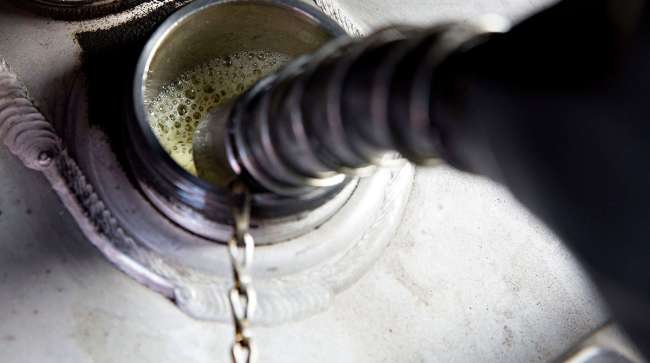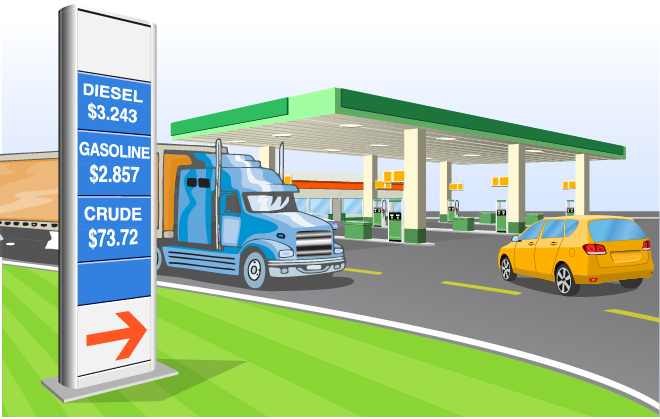Diesel Inches Up 0.7¢ to $3.243

The U.S. average retail price of diesel inched up 0.7 cent to $3.243 a gallon while crude prices were flat.
Though slight, the gain was the second consecutive increase in the price of diesel, which has risen 2.7 cents over that period.
Trucking’s main fuel costs 76.2 cents a gallon more than it did a year ago, when the price was $2.481, the Department of Energy said July 9.

Regional average diesel prices rose in all areas except the West Coast (less California) where it was down 0.4 cent a gallon as well as in New England where it was down 0.3 cent.
The national average price for regular gasoline rose 1.3 cents to $2.857 a gallon, DOE’s Energy Information Administration said. The average is 56 cents higher than it was a year ago.
Some diesel price stability may be at hand.
In its latest Short-Term Energy Outlook, EIA forecast higher crude oil prices, and strengthening global diesel demand will lead to the average price diesel in 2018 of $3.14 a gallon — dropping to an average of $3.07 in 2019.
When it comes to fueling trucks, there are some things you can control and some you can’t, one executive at a truck leasing company said.
“The commodity piece is what it is,” Andrew Cullen, senior vice president of Fuels and Facility Services at Penske Truck Leasing, told Transport Topics. “The things we focus in on for our customers are the quality of the fuel and security of supply. These are very, very important to them.”
For instance, in winter, Penske has a very strict blending program and tests its fuel to ensure that customers at its locations get an appropriate fuel, no matter if they are running in Minnesota or Kentucky or another part of the country, he said.
At the same time, the company offers customers a Penske fuel card, he said, “to provide visibility of the price they pay through our locations and our travel center partners. I think our pricing is very competitive. We try to help them make the best and most competitive fueling decision on a daily basis.”
Meanwhile, another hurricane season is underway.
Hurricanes and other weather-related events carry the potential for flooding, and pipeline and refinery disruptions affecting supply.
“Those are always challenges that our customers have to face in this industry,” Cullen said.
Penske partners with its suppliers to ensure business continuity and disaster recovery plans in place for reviews annually.
“That includes additional supply points that Penske can get product from if the primary source is down,” he said.
Forecasters at the National Oceanic and Atmospheric Administration predicted a 35% chance of an above-normal season, a 40% chance of a near-normal season, and a 25% chance of a below-normal season for the 2018 hurricane season that spans June 1 to Nov. 30.
NOAA, a unit of the U.S. Department of Commerce, has made advances in both hardware and computing since the last hurricane season, increasing the agency’s ability to both predict the path of storms and warn Americans in their path, Commerce Secretary Wilbur Ross said in a statement.
“The devastating hurricane season of 2017 demonstrated the necessity for prompt and accurate hurricane forecasts,” Ross said.
Three hurricanes smashed into the Gulf Coast region in 2017, causing major outages of refinery production and other problems, with the most devastating being Hurricane Harvey that hovered over Houston. Hurricane Irma laid waste to Florida, disrupting fuel deliveries to ports there.
Also, Hurricane Maria savaged Puerto Rico, while Hurricane Nate arrived along the Gulf Coast late in the season, bringing flooding, power outages and structural damage.
In the meantime, crude oil futures trading on the New York Mercantile Exchange closed July 9 at $73.72 per barrel compared with $73.79 on July 2.
On July 11, WTI crude for August delivery slipped $3.73 to settle at $70.38 a barrel, the biggest decline since June 2017.
The drop reflected the escalating U.S.-China trade war that threatens economic growth, according to Bloomberg News.
As for inventory levels, U.S. commercial crude oil inventories on July 6 decreased by 12.6 million barrels compared with the week ending June 29, EIA reported. At 405.2 million barrels, oil inventories are about 4% below the five-year average for this time of year.
Total motor gasoline inventories decreased by 700,000 barrels and are about 6% above the five-year average for this time of year. Distillate fuel inventories — primarily ultra-low sulfur diesel used in transportation and to a lesser degree as heating oil — increased by 4.1 million barrels last week and are about 12% below the five-year average for this time of year.



